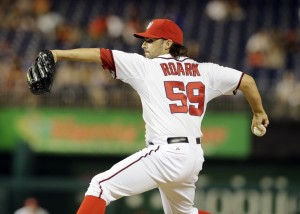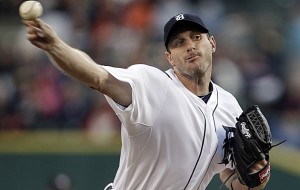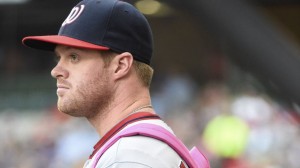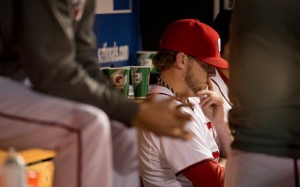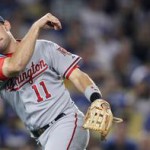I havn’t posted something in weeks. I was facing writers block. What is there to really write about in the early weeks of Spring Training? Thankfully, MLB.com beat reporter Bill Ladson piped up with an inbox!
As always, these are (presumably) real questions from (presumably) real Nats fans who took time out of their busy day to email Ladson personally. And as always, i write my response here before reading his so as not to color my own opinion.
Q: Would the Nationals consider a six-man rotation so Tanner Roark isn’t left out?
A: Uh, no. You don’t commit $210M to Max Scherzer and then immediately tell him and all the other veterans in the rotation that their entire work preparation process is going to be adjusted, for the first time ever by any MLB team, to account for a guy with a year and a half of service in Tanner Roark.
By going to a 6-man rotation for an entire 162-game season, you’d be lowering the number of starts for each guy by at least 6. What would you rather have, 6 less starts by the likes of Scherzer and Strasburg, or 20-some starts for Roark? I like Roark too, and trust me I wouldn’t mind a bit for a trade to enable him to be the 5th starter again, but this team has made its bed with this contract.
Ladson says that Roark will be in the bullpen as the long man when the season starts. Cutting-edge analysis!
Q: If the Nationals and Jordan Zimmermann cannot come to an agreement and he signs somewhere else, what kind of effect will this have on the Nationals in general?
A: Not as much as you might think. Yes, losing a near-Ace is never good, but this team has a 5-win starter pushed to the bullpen right now, and has significant depth in AAA. I’m of the belief that a lot of the Scherzer signing was about providing rotation stability through the next few years as the team (likely) parts ways with a significant portion of its current rotation through free agency. Two years from now you’re probably looking at a rotation that goes Scherzer, Gonzalez, Roark, Cole and Giolito. And the Nats will have likely acquired a whole slew of upper-level prospects either by trade or by virtue of supplemental draft picks. Ladson confidently says “there will be no effect at all” because Matt Williams “won’t allow it.” Beat reporter bravado? Of *course* there will be an effect; we’re talking about what will probably be a difficult and nasty separation when all is said and done.
Q: Why is Gio Gonzalez starting over Roark? Roark is clearly better. Gio won’t throw strikes.
A: Simple answer: because Gonzalez is lefty. Secondary issue; Gonzalez is getting paid more than 20 *times* what Roark is in 2015. I’m not entirely in disagreement here; I’ve been a Roark believer ever since he got called up. But he’s going to be the odd man out in this competition no matter how good he looks this spring. Ladson says Gio was his good ole self after getting past his shoulder injury.
Q: I like Drew Storen and his numbers are, overall, excellent. I have to admit, though, I worry about him in close games in the postseason. Am I overly concerned about the fact that 2012 and ’14 playoffs saw him blow saves in key games?
A: Three words for you: Short. Sample. Size. Like it or not (and I too fall victim to this), you just can’t look at a couple of outings in the post-season and judge a guy. Exhibit 1a: Clayton Kershaw‘s career post-season era is 5.12. I killed Storen‘s 2014 NLDS performance too, but in reality he was rather unlucky to blow Zimmermann’s gem (Posey kind of fisted the ball into center and then Sandoval hit a down-and-away pitch for a very well-placed double to tie the game). Storen’s regular season record speaks for itself right now: he had a frigging 1.12 ERA last year!
I say, lets worry about *making* the post-season first, then lets see how the games go. At some point you have to think the Nats will, you know, hit the ball in a post-season series to the point where it won’t matter whether our closer will pitch a 1-2-3 ninth. Lets you forget: the team slash line in the 2014 NLDS was .164/.222/.258 and in the 2012 NLDS was .232/.290/.393. That’s not very good.
Ladson basically says the same thing.
Q: Do you expect a significant contribution from any of the players signed to Minor League contracts?
A: We already talked about the NRIs in depth. Short answer is this: *maybe* one of the veteran right handers might have an impact but not immediately. And we might very well see one of the lefty-hitting vets pushing Tyler Moore for the last spot on the roster. Ladson thinks Mike Carp in particular is going to contribute off the bench … which means he’s predicting Carp to make the 25-man roster?
Q: Which Minor Leaguers could get called up during the season?
A: I think we’ll see at least three of the AAA starters at some point during the year (guessing Treinen, Cole and Jordan). I could see Matt Grace getting some MLB time. I’m sure we’ll see a backup catcher in Dan Butler at some point. If Michael Taylor doesn’t start out on the 25-man roster to replace Jayson Werth, then i’m sure we’ll see him at some point.
Perhaps a better question would be this: what non-40man roster guys could you see getting call-ups mid-season? Rafael Martin comes to mind, as well as someone like Emmanuel Burriss or Matt Skole if the team gets stuck on the injury front.
Ladson mentions Cole and Grace … and then says that he could see Giolito getting a September call-up. That’s the dumbest thing i’ve read in a while. Why in god’s name would we want to start Giolito’s clock early like that?? If he’s MLB ready by the end of 2015 …. then you sit on him in AAA for two weeks in 2016 and call him up mid-April. That’s it. Every day he spends pitching useless innings in Sept 2015 would be another day the team has to wait for him in 2016.
Q: Do you see Danny Espinosa on this team in 2016? It seems like he has gotten a lot more slack than anyone on the team. Additionally, what are the team’s long-term plans for second base?
A: I see no reason for Espinosa not to be on this team in 2016, if he continues to serve as an adequate backup. There’s no reason to cut him, and there’s not really anyone better who is that close to the majors. I’m not sure if i’d characterize the way the Nationals have handled him as “slack;” in fact the Nats have now gone out of their way to replace him as the starter both with the Cabrera trade mid-2014 and with the Escobar trade this past off-season. Long term you have to think the team is waiting for Wilmer Difo as the long-term 2B solution .. if he can step it up and advance two levels in 2015 he may be ready by mid 2016. I’m not as convinced that Tony Renda (who is “ahead” of Difo on the org 2b chart) is a real MLB prospect at this point. There’s practically nobody of interest at either AAA or AA right now who rates as a prospect. There’s also a possiblity that newly-acquired-but-not-yet-with-us Trea Turner could be a solution … but the team is hoping he can stick at short. Ladson basically agrees.
